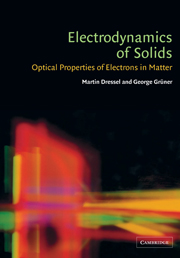Book contents
- Frontmatter
- Contents
- Preface
- 1 Introduction
- PART ONE CONCEPTS AND PROPERTIES
- PART TWO METHODS
- PART THREE EXPERIMENTS
- PART FOUR APPENDICES
- Appendix A Fourier and Laplace transformations
- Appendix B Medium of finite thickness
- Appendix C k·p perturbation theory
- Appendix D Sum rules
- Appendix E Non-local response
- Appendix F Dielectric response in reduced dimensions
- Appendix G Important constants and units
- Index
Appendix F - Dielectric response in reduced dimensions
Published online by Cambridge University Press: 20 May 2010
- Frontmatter
- Contents
- Preface
- 1 Introduction
- PART ONE CONCEPTS AND PROPERTIES
- PART TWO METHODS
- PART THREE EXPERIMENTS
- PART FOUR APPENDICES
- Appendix A Fourier and Laplace transformations
- Appendix B Medium of finite thickness
- Appendix C k·p perturbation theory
- Appendix D Sum rules
- Appendix E Non-local response
- Appendix F Dielectric response in reduced dimensions
- Appendix G Important constants and units
- Index
Summary
With a few exceptions we have considered mainly bulk properties in the book. The physics of reduced dimensions is not only of theoretical interest, for many models can be solved analytically in one dimension only. A variety of interesting phenomena are bounded to restricted dimensions. On the other hand, fundamental models such as the theory of Fermi liquids developed for three dimensions break down in one or two dimensions. In recent years a number of possibilities have surfaced to explain how reduced dimensions can be achieved in real systems. One avenue is the study of real crystals with an extremely large anisotropy. The second approach considers artificial structures such as interfaces which might be confined further to reach the one-dimensional limit.
Dielectric response function in two dimensions
Reducing the dimension from three to two significantly changes many properties of the electron gas. If the thickness of the layer is smaller than the extension of the electronic wavefunction, the energy of the system is quantized (size quantization). We consider only the ground state to be occupied. For any practical case, just the electrons are confined to a thin sheet, while the field lines pass through the surrounding material which usually is a dielectric. A good approximation of a two-dimensional electron gas can be obtained in surfaces, semiconductor interfaces, and inversion layers; a detailed discussion which also takes the dielectric properties of the surrounding media into account can be found in [And82, Hau94].
Information
- Type
- Chapter
- Information
- Electrodynamics of SolidsOptical Properties of Electrons in Matter, pp. 445 - 460Publisher: Cambridge University PressPrint publication year: 2002
